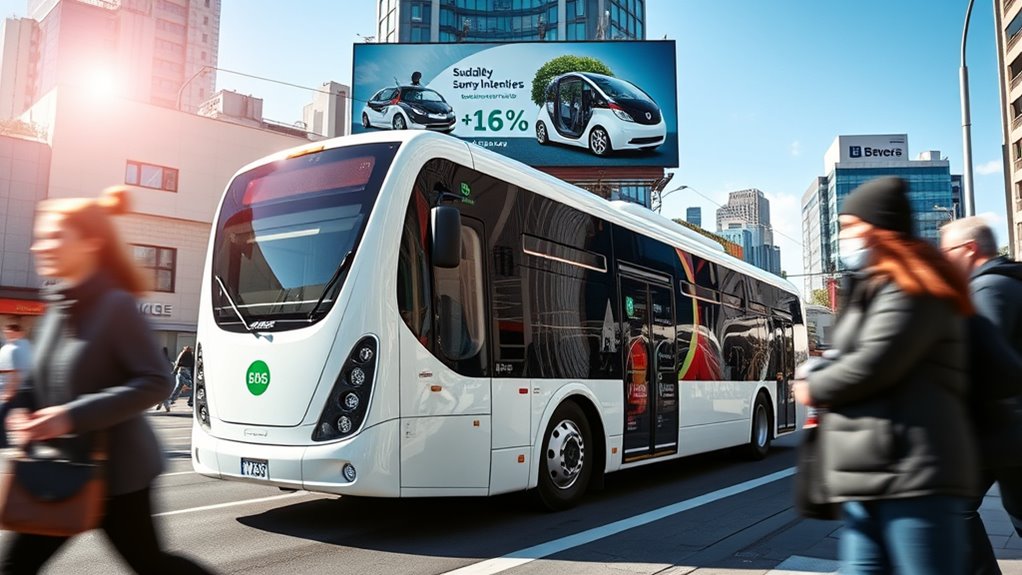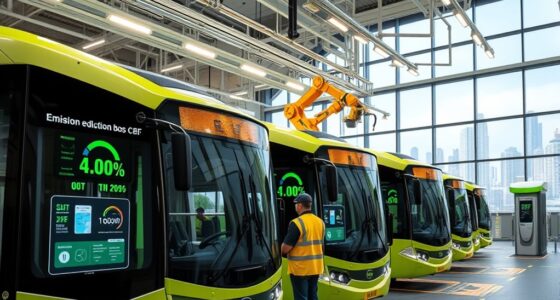Exploring electric bus subsidies can seem overwhelming since federal, state, and local programs all have different requirements and incentives. You need to understand eligibility, funding options like grants, rebates, and tax credits, and how they work together to reduce costs. Subsidies aim to make electric buses more affordable, help shift away from diesel, and promote sustainability. Keep exploring the details, and you’ll discover ways to maximize these incentives for your projects.
Key Takeaways
- Understand federal, state, and local funding sources, including grants, rebates, and tax credits, to maximize financial support.
- Check eligibility requirements for transit agencies, non-profits, and tribes, ensuring project alignment with sustainability goals.
- Combine multiple incentives strategically to reduce upfront costs and enhance long-term economic benefits.
- Recognize the environmental advantages of electric buses, such as zero emissions and improved air quality, to support funding applications.
- Stay informed on policy updates and funding opportunities to navigate the evolving landscape of electric bus subsidies effectively.

Electric bus subsidies play a crucial role in accelerating the adoption of cleaner transportation options. They make electric buses more financially accessible, helping transit agencies, private companies, and organizations shift away from traditional diesel models. Federal incentives like the Qualified Commercial Clean Vehicle Credit can provide up to $40,000 per electric bus, markedly reducing the initial purchase cost. Many states also offer additional subsidies, further lowering expenses and encouraging local adoption. These combined efforts create a more compelling case for switching to electric, especially when you consider that subsidies can tip the scales toward cost competitiveness with diesel buses.
You, as a recipient—whether a municipal agency, private operator, or non-profit—can access various funding sources. Federal Transit Administration (FTA) grants are directly available to municipalities and bus operators, easing the financial burden of procurement and infrastructure upgrades. Many states supplement these grants with their own programs, often designed to foster regional electric bus fleets. Recognized non-profits involved in public transportation can also tap into these subsidies, along with Indian tribes seeking to modernize their transit services. Eligibility typically hinges on project competitiveness and how well the proposal aligns with broader transportation goals.
The types of subsidies are diverse. Tax credits, like the Qualified Commercial Clean Vehicle Credit, offer direct financial incentives when purchasing electric buses. Grants provide competitive funding for acquiring vehicles or building charging infrastructure, helping offset the higher upfront costs. Some programs also include rebates or direct funding, making the transition more affordable. These incentives are part of broader initiatives aimed at reducing emissions by promoting low-emission vehicles. They not only lessen the financial barrier but also support a shift toward sustainable transportation systems. Moreover, financial incentives can sometimes be combined to maximize the affordability of electric bus projects. Additionally, the availability of cost-saving measures further encourages organizations to adopt electric fleets.
The environmental benefits of these subsidies are substantial. Electric buses produce no tailpipe emissions, which drastically cuts greenhouse gases and local pollutants. This helps improve air quality and reduces the transportation sector’s carbon footprint. As you adopt electric buses through these subsidies, you’re contributing to a more sustainable and healthier environment. Additionally, the availability of affordable financing options further enhances the feasibility of adopting electric fleets for many organizations. Furthermore, increased government focus on sustainable transportation can lead to more innovative subsidy programs in the future, expanding opportunities for organizations to transition.
Electric buses also tend to be more energy-efficient over their lifespan, offering long-term environmental advantages that go beyond initial costs. From an economic perspective, subsidies help achieve cost parity between electric and diesel buses. When factoring in subsidies and lower operational costs—such as reduced fuel and maintenance expenses—electric buses become more financially viable. This financial feasibility encourages more organizations to invest in electric fleets, thereby increasing market uptake rates. Ultimately, subsidies mitigate the fiscal costs associated with transitioning, making electric buses a smart choice for those committed to sustainability and economic efficiency.
Frequently Asked Questions
How Do Subsidy Programs Vary Between Countries?
You’ll notice that subsidy programs differ across countries. In the Netherlands and Italy, you get substantial purchase-cost coverage and tax incentives, encouraging operators to buy e-buses.
The UK offers grants for zero-emission buses and charging infrastructure.
Germany shifted focus from subsidies to charging networks after 2024.
These variations reflect each nation’s policies, funding structures, and regional priorities, impacting how quickly electric buses are adopted in different areas.
What Are Common Eligibility Criteria for Electric Bus Subsidies?
You should know that common eligibility criteria for electric bus subsidies include compliance with environmental laws like the Clean Air Act and ADA requirements. Your project must focus on low or no emission vehicles, and you’ll need to plan for infrastructure upgrades like charging stations.
Additionally, matching funds are often required, and projects must align with specific funding windows and statutory rules, emphasizing workforce development and environmental benefits.
Are There Long-Term Financial Benefits Beyond Initial Subsidies?
You might wonder if electric buses truly pay off in the long run. The answer is yes. Beyond initial subsidies, you’ll save money with lower operating and maintenance costs, fuel savings, and potential revenue from Vehicle-to-Grid technology.
These benefits can lead to a payback period of around five years, making electric buses a smart, sustainable choice that keeps your transportation system both cost-effective and environmentally friendly over time.
How Do Subsidies Impact Electric Bus Maintenance Costs?
Subsidies play a key role in lowering electric bus maintenance costs by supporting infrastructure development and maintenance training. They help offset higher upfront expenses, encouraging adoption and ensuring newer, more reliable technology.
With fewer moving parts and advanced diagnostics, electric buses require less frequent repairs, which lowers long-term costs. Your fleet benefits from reduced labor and parts expenses, making electric buses more economical over their lifespan, especially with continued subsidy support.
What Is the Process for Applying for Electric Bus Subsidies?
Imagine a key opening new roads; that’s how applying for electric bus subsidies feels. You start by filling out a short federal rebate form via the EPA portal, ensuring your fleet meets eligibility.
Next, you gather utility partnership proof, school approval, and review example contracts if you’re in Texas.
Submit all documents before deadlines, keep your registrations active, and stay compliant with post-award requirements to drive your project forward.
Conclusion
So, buckle up, because steering electric bus subsidies can feel like steering through a tornado of policies and paperwork. But with a little patience, you’ll open a treasure trove of savings and eco-friendly power that’ll transform your transit game forever. Imagine revolutionizing your fleet overnight—cutting emissions, slashing costs, and becoming a hero of sustainability. It’s not just a subsidy; it’s your ticket to leading the charge into a cleaner, brighter future.









